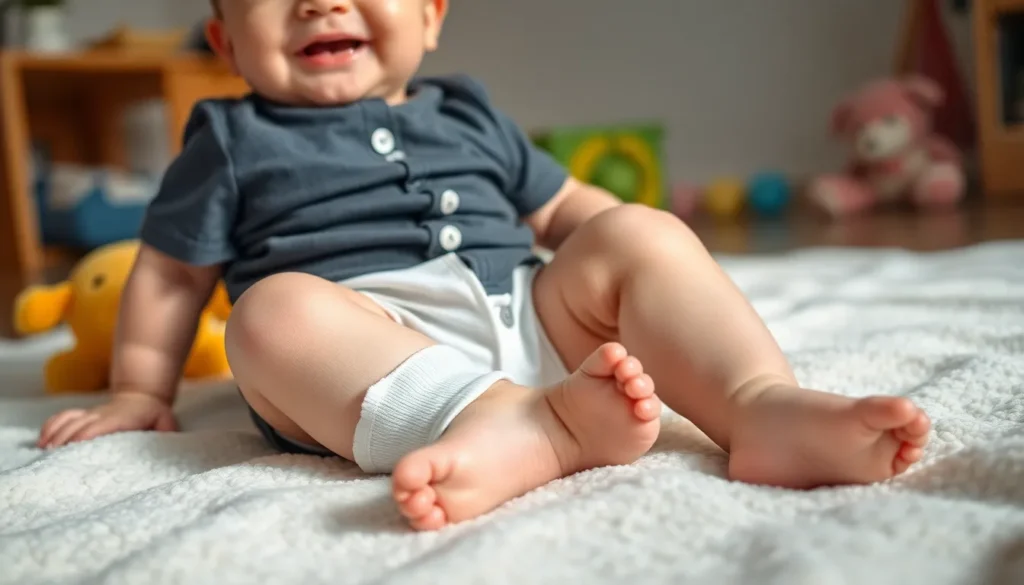When it comes to babies, everyone loves those chubby cheeks and tiny fingers, but have you ever stopped to marvel at their kneecaps? Yes, you heard that right! Those adorable little joints are more than just a cute accessory; they’re a fascinating part of infant anatomy that often gets overlooked.
Understanding Babies Kneecaps
Babies’ kneecaps play a crucial role in their development. This section explores the unique anatomy and the timeline of kneecap formation in infants.
Anatomy of Babies Kneecaps
Babies’ kneecaps, known as patella, differ significantly from those of adults. Initially, they consist mainly of cartilage instead of bone. This cartilage provides flexibility, allowing for safe movement during early gross motor skill development. Over time, gradual ossification transforms the cartilage into bone. This process ensures that kneecaps can support weight and movement as the child grows.
Developmental Timeline
Kneecap development occurs in stages. Infants are born with cartilage kneecaps, which begin the ossification process around ages 2 to 6. By age 10, most children will have fully formed kneecaps. Growth during the toddler years is essential for strength and mobility. Physical activities like crawling and walking contribute to this growth, helping enhance muscle coordination around the knees. Tracking this timeline is vital for understanding pediatric development.
Importance of Babies Kneecaps

Babies’ kneecaps play a crucial role in their physical development. Understanding their significance aids in appreciating how they contribute to mobility and growth.
Impact on Mobility
Mobility in infants relies heavily on the flexibility offered by their cartilage-based kneecaps. These soft structures allow for a greater range of motion during initial stages of movement, such as crawling and standing. As babies build strength through activities, the kneecaps adapt to support these actions. This support enhances coordination and balance, helping infants progress toward walking. Mobility is essential for overall exploration and interaction with their environment.
Role in Growth and Development
Kneecaps are integral to the growth process, beginning their transformation from cartilage to bone between ages 2 and 6. This ossification is crucial for ensuring proper support as children engage in physical activities. As kneecaps solidify, they strengthen the joints, promoting stability during movement. Each stage of growth builds muscle coordination, benefiting children’s ability to run and jump. Healthy kneecaps thus contribute to a child’s overall developmental milestones, ensuring they achieve physical benchmarks effectively.
Common Concerns About Babies Kneecaps
Parents often raise concerns regarding the development of their babies’ kneecaps. Understanding the signs and symptoms can ensure the best outcome for the child.
Warnings to Look Out For
Parents should observe for unusual swelling around the knees. Swelling might indicate injury or an underlying condition. Signs of pain during movement also warrant attention. Babies should not exhibit discomfort when crawling or standing. Difficulty in movement may suggest issues with kneecap development. Watch for any visible deformities as well. Any irregularities in leg alignment may require further evaluation. Early detection of these concerns can facilitate timely intervention.
When to Consult a Pediatrician
Consulting a pediatrician is crucial if parents notice persistent concerns. Symptoms that last longer than a few days should prompt a visit. Experienced pediatricians can assess kneecap formation effectively. If a baby shows signs of limping, it’s vital to seek professional advice. In cases of frequent falls or difficulty in balance, timely consultation is necessary. Pediatricians can determine whether these issues relate to kneecap development. Regular check-ups also ensure healthy growth and development.
Caring for Babies Kneecaps
Caring for babies’ kneecaps requires attention to their unique developmental needs. It’s essential to provide proper support and engage in recommended activities that promote healthy growth.
Proper Support and Comfort
Maintaining proper support ensures the kneecaps develop correctly. Use soft, padded surfaces during playtime to help protect fragile cartilage. Positioning infants on their backs and tummy time promote knee strength and flexibility. Ensure footwear fits well when the child starts walking, as improperly sized shoes can lead to discomfort. Regularly check that toys and play areas are safe, minimizing the risk of falls that could affect the knees. Comfort contributes to a positive environment, allowing babies to explore and strengthen their knees effectively.
Recommended Activities
Engaging in recommended activities boosts babies’ kneecap development. Allow infants to crawl on different surfaces; this builds strength and coordination. Encouraging rolling motions helps babies develop flexibility around the knees. Activities such as gentle leg stretches improve muscle engagement around the kneecap. Avoid excessive pressure on the knees, especially during early stages. Provide opportunities for assisted standing, stimulating muscle growth and confidence. Interactive play fosters a sense of balance and stability, crucial for future mobility milestones.
Understanding the significance of babies’ kneecaps offers valuable insight into their physical development. These unique structures play a crucial role in providing flexibility and support as infants explore their world. As they progress through essential milestones like crawling and walking, healthy kneecaps are vital for their overall mobility and coordination.
Parents should remain attentive to their child’s kneecap health, recognizing signs that may indicate underlying issues. By fostering an environment that promotes safe movement and strength-building activities, caregivers can support their child’s growth effectively. Prioritizing knee health not only aids in immediate development but also lays the foundation for future physical activities.





